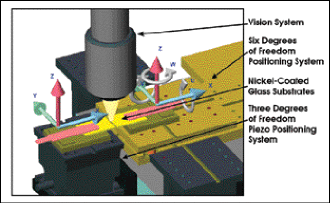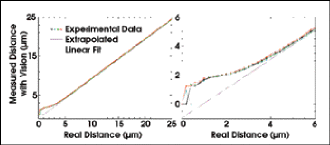Axel Wille, Steffen Rau and Rainer Gloess, Physik Instrumente
Alignment of tiny objects is an important task in the photonics industry. Fibers, waveguides and microlenses must be adjusted to maximize light throughput or to prepare for gluing or welding. Unfortunately, imaging systems used for automated component production in the micron range face optical limits. Physik Instrumente, a German manufacturer of photonic alignment systems, has developed a method that can determine the relation of apparent sizes and distances of objects viewed with a vision system to the real dimensions by reducing its measuring and positioning tasks to microns.
In the measurement of apparent vs. real distance of two rectangular flat solids, the electrical contact of both solids determines when the real distance is zero (Figure 1). A calibrated piezo positioner then moves one solid to enlarge the distance between the solids with nanometer resolution.

Figure 1. The lens system is positioned over two coated substrates that are mounted on a 3-D piezo stage (left) and on a 6-D hexapod system (right).
The rectangular solids consist of well-finished glass substrates. To detect the distance between the two substrates, a 0.5-µm layer of sputtered nickel is made. That layer enables the detection of the electrical contact. One substrate is mounted on a 3-D piezoelectric stage (NanoCube) and the second one, on the platform of the fine alignment station hexapod. The smallest step size of the NanoCube is 2 nm. To ensure that the front planes of the solids are coplanar and the observed top edges are parallel, the two solids must be aligned in six degrees of freedom.
The NanoCube System was calibrated by a laser interferometer. Both parts were lightly clamped on a ceramic plate to avoid friction. An illumination system with a row of LEDs was placed under a diffuse plastic sheet. The LEDs was transmit light, while the imaging system views from the top. The imaging system consists of an objective with 13.3X magnification mounted to a tube, which is connected to a standard CCIR camera.
With this setup, we could guarantee a predetermined distance between the two substrates to about 0.01 µm. This high resolution was achieved by using piezo technology.
The glass objects are aligned with Physik Instrumente's Motion & Vision software so that the front planes are parallel. The top edges of the front planes are positioned into the field of view and moved into the focal plane with an autofocus routine. The substrates are moved until the gap is closed and electrical contact is established. At this point, the measurement begins. The NanoCube (resolution <2 nm) moves one substrate in 200-nm steps away from the second object. The vision system detects the gap and its apparent size. The measured distance by vision is plotted vs. the NanoCube position (Figure 2).

Figure 2. The apparent distance measured optically is plotted vs. the real distance of two rectangular substrates. The left graph shows the linear relation for large distances, while the right plot focuses on the critical small distances.
In the graph at left, the slope for distances larger than 5 µm is 1.01 ±0.001. This error of 1 percent may be caused by the calibration. The extrapolation of this linear fit to 0 determines the offset of 0.75 to 1 µm, which means a systematic error of less than 1 µm for distance measurements. For small distances (right graph), the relation is no longer linear, which is probably due to diffraction.
With the method, a calibration of the camera system can be performed. This method allows positioning and alignment of components down to 1 µm. Without the calibration, the measured distances are higher than the real distances, which might cause the optical components to collide.